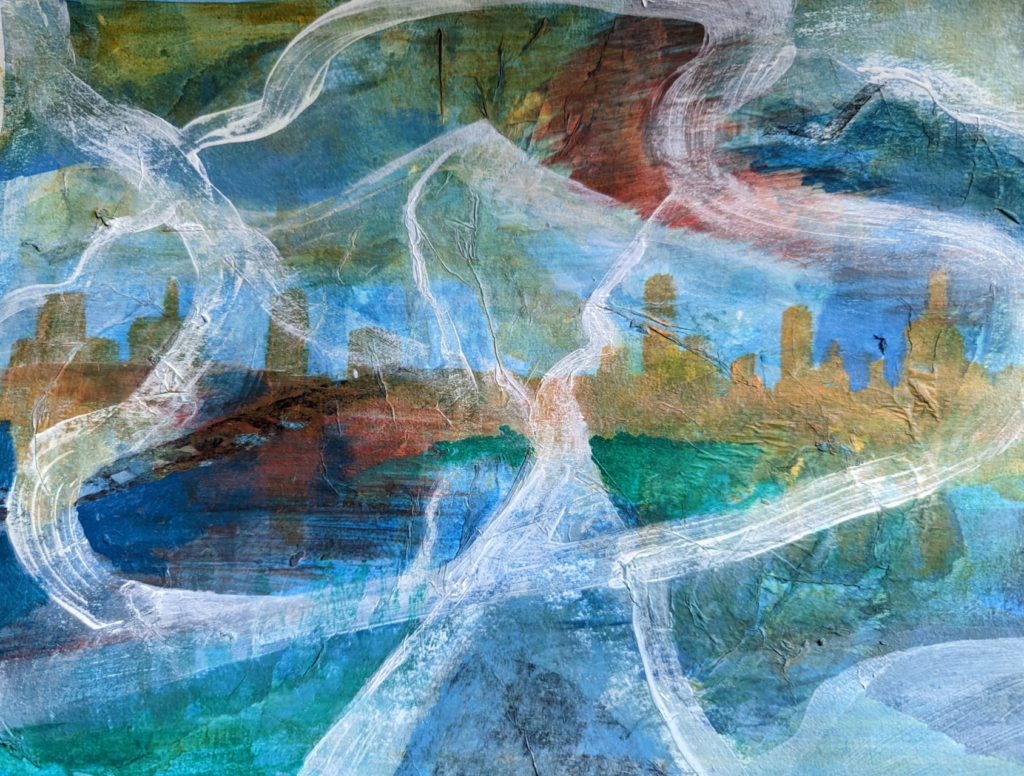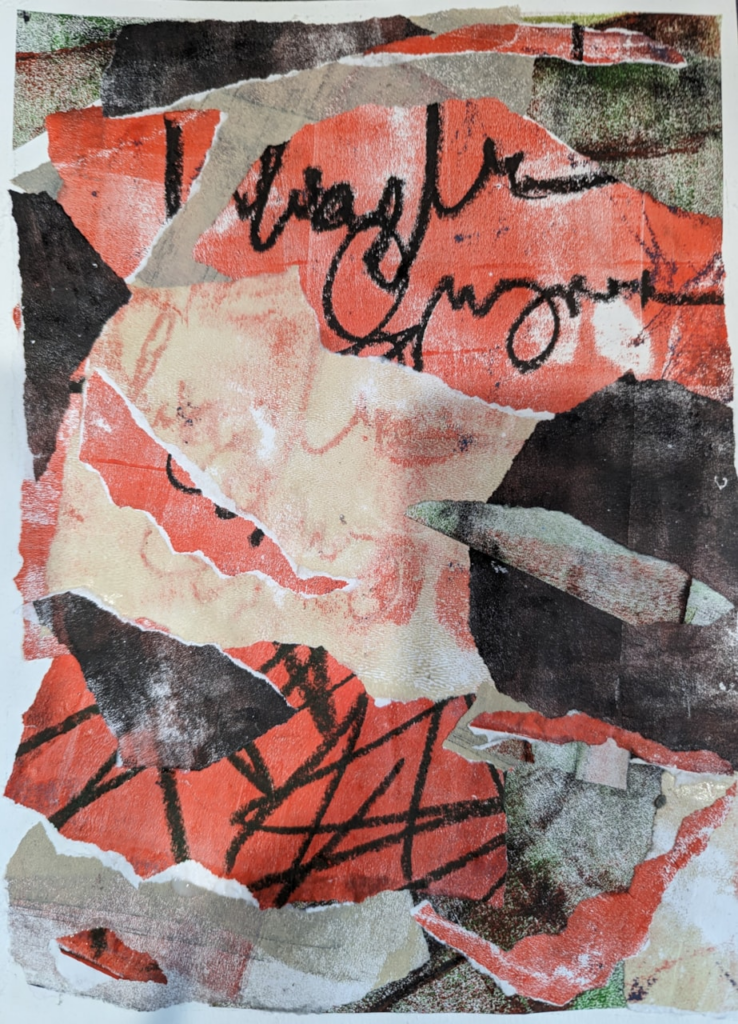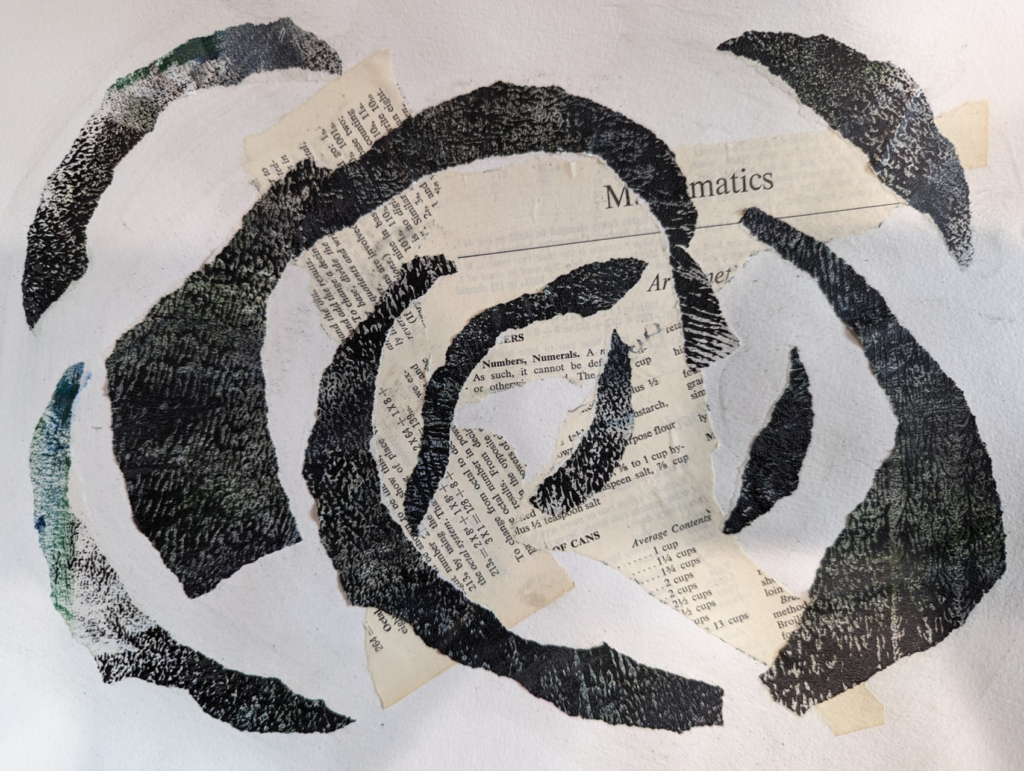



Donna Vorreyer is the author of three full-length poetry collections: To Everything There Is (2020), Every Love Story is an Apocalypse Story (2016) and A House of Many Windows (2013), all from Sundress Publications. Recent work has appeared or is forthcoming in Ploughshares, Colorado Review, Harpur Palate, Baltimore Review, and Booth. Her visual art has been featured in North American Review, Waxwing, About Place, Pithead Chapel, and other journals. Donna currently lives and creates in the western suburbs of Chicago and runs the monthly online reading series A Hundred Pitchers of Honey.
Charlise Bar-Shai: What made you want to become a visual artist?
Donna Vorreyer: I have always loved to view visual art, and I was lucky enough to grow up with the Art Institute of Chicago just a short el ride away. I also used to love making visual art when I was young, and even won keys in some Scholastic Art competitions in junior high. But I moved away from it as I grew more interested in writing, and since I had limited time for creative pursuits as a full-time middle school teacher, the writing took precedence. I retired during the pandemic lockdown, and having so much time at home allowed me to start tinkering with some attempts at visual art: small daily sketches of things I had around me at home, some black and white grid portraits based on old photographs, some collage work with found material. The joy I got from that sort of creative work was less stressful and different from writing. I decided to take a class with poet Ciona Rouse and her sister, artist Lanecia Rouse Tinsley, and their encouragement to use what I knew from the writing process to explore the visual set me on a path to start creating more visual art. Over the past three years, I have used their encouragement (as well as online videos and tutorials) to try to grow as a visual artist, focusing mostly on abstract work. I do it mostly for the enjoyment of it, to see what I can learn, how I can grow, what themes emerge as I learn to experiment with shape, color, and texture.
CB: Have your written works inspired your visual pieces? Is there an overlap in your creative process?
DV: That’s an interesting question and the answer is no, not really. So far, it has been helpful for me to keep those two processes separate. I have been writing my whole life, and I have had some “success” as a writer, in terms of publication, so I feel a certain type of pressure when I’m writing, a pressure to make it “good,” to live up to what I’ve done in the past. I have no such ego about art. I can more easily mess up and laugh about it than I can with the written word. In that respect, making visual art is less stressful for me than writing, and I’d like to keep it that way.
Working on a poem has a completely different feel than working on a painting, but what writing and painting have in common is that they both start messy – just getting things down, not necessarily focused and certainly not precise. It is in the next steps that they diverge. When I write, I love to revise, to focus on the diction, the sound, the line breaks and form, sometimes over months, before deciding that a poem is done. Each of these moves is deliberate as I make my way toward a final piece that is doing what I want it to do. In making visual art, I have a tendency to experiment more, to add and remove elements until I have a pleasing arrangement, sometimes completely foregoing an original plan or idea to follow something that emerges in the making.
CB: Did your time as an educator influence your artistic process? Did your students inspire you?
DV: My students always inspired me when I was teaching, not only with their own talents but with their joy and openness to the world, their ability to take risks and try things that were new to them. In that way, I think that they have influenced my process in the sense that I have had to follow my own advice. I used to tell my students that no one could ever ask them for any more than their best, and that doing your best is what matters, even if it doesn’t have the result you want or expect. When I make a piece of visual art, I keep that mantra in my head, as things often don’t turn out how I want or expect them to, but I’ve found a way to embrace that and move forward from those “failures” and see what I can learn from the experience.
CB: Have you arranged a solo exhibition for your work? Do you have a plan for one?
DV: I still have a hard time calling myself an artist, and I also have absolutely no knowledge of navigating the world of art in that way. (I have noticed that it is very expensive to enter shows, etc., which makes me nervous.) But my local library will be exhibiting a collection of my work in the new year, and that is exciting to me. So far, I have stayed within the world of literary journals, which is familiar, in terms of sending my art into the world to see what others may enjoy. Who knows what the future might hold?
CB: What has been the biggest challenge you’ve faced as an artist so far?
DV: The biggest challenge has been to let go of my inner critic. My good friend, writer and artist Kristin LaTour, has been so helpful to me in that respect—if it’s no good, it’s just paper. Throw it away. If it’s on canvas, paint over it. Just have fun. And I’ve also created a group of writer friends who also make visual art —we live all over the country, so we share in a group online where we are sending work, what we are making, how we are feeling about it. It’s helped me keep moving forward, to view myself as an artist, and to recognize that I don’t have to be a good representational illustrator to create something beautiful.
CB: I want to discuss your piece “Order and Chaos.” I love the way you seamlessly blended painting and collage. Can you describe your process when creating it?
DV: “Order and Chaos” began with collaging pieces of an old dictionary page regarding Mathematics. I placed them haphazardly onto the paper, almost in defiance of the rules and order that Math requires.
The other layer began with creating painted papers in dark shades (mostly black) with hints of greens and blues. Once the papers were painted, using a brayer to leave the grainy texture, I ripped them into curved shapes before placing them in a cyclical pattern that was more orderly than the text pieces. I like that the piece can work in multiple directions and places the text almost in the “eye” of the circles.
I often paint and rip papers to give the appearance of brush strokes in collage rather than using clean edges. I find it pleasing and more organic. I’m particularly pleased that this piece now has the perfect home with a dear friend who was a Mathematics teacher for years.
- An Interview with Colomba Klenner - January 8, 2024
- An Interview with Donna Vorreyer - November 27, 2023